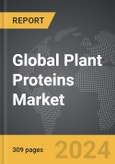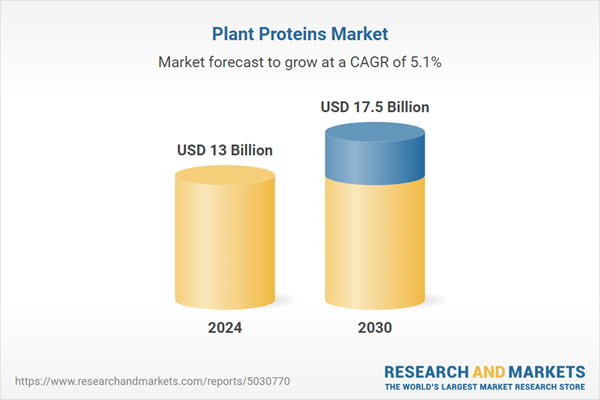Global Plant Proteins Market - Key Trends and Drivers Summarized
Fueling the Future: The Rise of Plant Proteins
Plant proteins are proteins derived from plant sources, providing a sustainable and nutritious alternative to animal-based proteins. These proteins are extracted from various plants, including soy, peas, rice, hemp, and legumes, through processes such as milling, soaking, and fermentation. Soy protein, one of the most common plant proteins, is extracted from soybeans and is highly valued for its complete amino acid profile. Pea protein, derived from yellow split peas, is known for its high digestibility and allergen-friendly properties. Other sources like rice and hemp are also gaining popularity due to their unique nutritional benefits and versatility in food applications. The extraction and processing of plant proteins aim to retain their nutritional integrity while enhancing their functional properties for use in a wide range of food products.How Are Plant Proteins Utilized in the Food Industry?
Plant proteins have become integral to the food industry, addressing the growing demand for healthy, sustainable, and ethical food options. They are widely used in the production of meat substitutes, such as plant-based burgers, sausages, and nuggets, which mimic the texture and taste of meat while offering a healthier alternative. Dairy alternatives, including plant-based milk, yogurt, and cheese, also rely heavily on plant proteins to provide the desired texture and nutritional profile. Additionally, plant proteins are incorporated into protein bars, shakes, and supplements, catering to the health-conscious and fitness markets. The versatility of plant proteins allows them to be used in baked goods, snacks, and cereals, enhancing their protein content and appeal to consumers seeking plant-based nutrition. The food industry's innovation in formulating diverse and palatable plant protein products has significantly contributed to the mainstream acceptance and popularity of these proteins.What Are the Current Trends in Plant Protein Research and Development?
The plant protein sector is experiencing rapid advancements and innovation, driven by ongoing research and development. One prominent trend is the focus on improving the taste and texture of plant-based products to more closely resemble animal proteins, addressing a critical barrier to consumer adoption. Biotechnology and food science advancements are enabling the development of novel plant protein sources, such as algae and insect-derived proteins, which offer unique nutritional profiles and environmental benefits. Another trend is the exploration of protein blends, combining different plant proteins to achieve a complete amino acid profile and enhanced functional properties. Sustainability is a key focus, with researchers working on more efficient and environmentally friendly methods of protein extraction and production. The rise of personalized nutrition is also influencing plant protein development, with products tailored to meet specific dietary needs and preferences. These trends reflect the dynamic and evolving nature of the plant protein industry, aiming to meet the diverse and changing demands of consumers.What Factors Are Driving the Growth in the Plant Proteins Market?
The growth in the plant proteins market is driven by several factors, reflecting the increasing demand for sustainable and health-conscious food options. Rising consumer awareness of the environmental and health impacts of animal agriculture is a significant driver, prompting a shift towards plant-based diets. Technological advancements in food processing and biotechnology are enhancing the quality and variety of plant protein products, making them more appealing and accessible to a broader audience. The expansion of the vegan and vegetarian populations, along with the growing interest in flexitarian diets, is also fueling market growth. Regulatory support and initiatives promoting sustainable food systems are encouraging the development and adoption of plant proteins. Additionally, the increasing prevalence of food allergies and intolerances is driving demand for allergen-friendly protein sources, further boosting the market. These factors collectively ensure robust growth in the plant proteins market, highlighting their critical role in shaping the future of food and nutrition.Report Scope
The report analyzes the Plant Proteins market, presented in terms of market value (USD). The analysis covers the key segments and geographic regions outlined below.- Segments: Source (Soy Protein, Wheat Protein, Pea Protein, Other Sources); Type (Concentrates, Isolates, Textured); Form (Dry, Liquid); Application (Food, Feed).
- Geographic Regions/Countries: World; United States; Canada; Japan; China; Europe (France; Germany; Italy; United Kingdom; Spain; Russia; and Rest of Europe); Asia-Pacific (Australia; India; South Korea; and Rest of Asia-Pacific); Latin America (Argentina; Brazil; Mexico; and Rest of Latin America); Middle East (Iran; Israel; Saudi Arabia; United Arab Emirates; and Rest of Middle East); and Africa.
Key Insights:
- Market Growth: Understand the significant growth trajectory of the Soy Protein segment, which is expected to reach US$13.1 Billion by 2030 with a CAGR of 5.7%. The Wheat Protein segment is also set to grow at 3.6% CAGR over the analysis period.
- Regional Analysis: Gain insights into the U.S. market, valued at $3.4 Billion in 2024, and China, forecasted to grow at an impressive 9% CAGR to reach $4.1 Billion by 2030. Discover growth trends in other key regions, including Japan, Canada, Germany, and the Asia-Pacific.
Why You Should Buy This Report:
- Detailed Market Analysis: Access a thorough analysis of the Global Plant Proteins Market, covering all major geographic regions and market segments.
- Competitive Insights: Get an overview of the competitive landscape, including the market presence of major players across different geographies.
- Future Trends and Drivers: Understand the key trends and drivers shaping the future of the Global Plant Proteins Market.
- Actionable Insights: Benefit from actionable insights that can help you identify new revenue opportunities and make strategic business decisions.
Key Questions Answered:
- How is the Global Plant Proteins Market expected to evolve by 2030?
- What are the main drivers and restraints affecting the market?
- Which market segments will grow the most over the forecast period?
- How will market shares for different regions and segments change by 2030?
- Who are the leading players in the market, and what are their prospects?
Report Features:
- Comprehensive Market Data: Independent analysis of annual sales and market forecasts in US$ Million from 2024 to 2030.
- In-Depth Regional Analysis: Detailed insights into key markets, including the U.S., China, Japan, Canada, Europe, Asia-Pacific, Latin America, Middle East, and Africa.
- Company Profiles: Coverage of players such as Axiom Foods, Inc., Cargill, Inc., Cosucra Groupe Warcoing SA, Dow, Inc., DuPont de Nemours, Inc. and more.
- Complimentary Updates: Receive free report updates for one year to keep you informed of the latest market developments.
Some of the 14 companies featured in this Plant Proteins market report include:
- Axiom Foods, Inc.
- Cargill, Inc.
- Cosucra Groupe Warcoing SA
- Dow, Inc.
- DuPont de Nemours, Inc.
- Ezaki Glico Co., Ltd.
- Farbest Brands
- Glanbia PLC
- Glico Nutrition Co., Ltd.
- Growing Naturals, LLC.
- Kerry Group PLC
- Norben Company Inc.
- Now Foods
- Pinnacle Foods, Inc.
- Roquette
- Shandong Jianyuan Foods Co., Ltd.
- The Scoular Company
- Yantai Shuangta Food Co., Ltd.
- A&B Ingredients
- Agridient
- Ajinomoto Co., Inc.
- Amway Corporation
- Archer Daniels Midland Company
This edition integrates the latest global trade and economic shifts into comprehensive market analysis. Key updates include:
- Tariff and Trade Impact: Insights into global tariff negotiations across 180+ countries, with analysis of supply chain turbulence, sourcing disruptions, and geographic realignment. Special focus on 2025 as a pivotal year for trade tensions, including updated perspectives on the Trump-era tariffs.
- Adjusted Forecasts and Analytics: Revised global and regional market forecasts through 2030, incorporating tariff effects, economic uncertainty, and structural changes in globalization. Includes historical analysis from 2015 to 2023.
- Strategic Market Dynamics: Evaluation of revised market prospects, regional outlooks, and key economic indicators such as population and urbanization trends.
- Innovation & Technology Trends: Latest developments in product and process innovation, emerging technologies, and key industry drivers shaping the competitive landscape.
- Competitive Intelligence: Updated global market share estimates for 2025, competitive positioning of major players (Strong/Active/Niche/Trivial), and refined focus on leading global brands and core players.
- Expert Insight & Commentary: Strategic analysis from economists, trade experts, and domain specialists to contextualize market shifts and identify emerging opportunities.
Table of Contents
Companies Mentioned (Partial List)
A selection of companies mentioned in this report includes, but is not limited to:
- Axiom Foods, Inc.
- Cargill, Inc.
- Cosucra Groupe Warcoing SA
- Dow, Inc.
- DuPont de Nemours, Inc.
- Ezaki Glico Co., Ltd.
- Farbest Brands
- Glanbia PLC
- Glico Nutrition Co., Ltd.
- Growing Naturals, LLC.
- Kerry Group PLC
- Norben Company Inc.
- Now Foods
- Pinnacle Foods, Inc.
- Roquette
- Shandong Jianyuan Foods Co., Ltd.
- The Scoular Company
- Yantai Shuangta Food Co., Ltd.
- A&B Ingredients
- Agridient
- Ajinomoto Co., Inc.
- Amway Corporation
- Archer Daniels Midland Company
Table Information
| Report Attribute | Details |
|---|---|
| No. of Pages | 440 |
| Published | December 2025 |
| Forecast Period | 2024 - 2030 |
| Estimated Market Value ( USD | $ 13 Billion |
| Forecasted Market Value ( USD | $ 17.5 Billion |
| Compound Annual Growth Rate | 5.1% |
| Regions Covered | Global |









